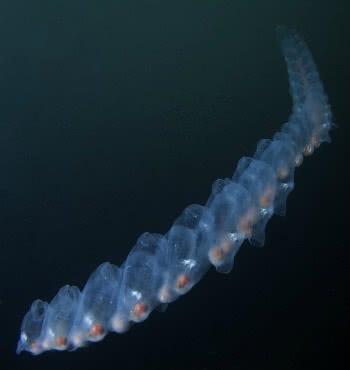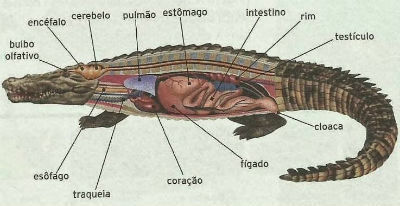Plant histology is the science that studies the tissues of plants.
It comprises the study of the characteristics, organization, structure and functions of plant tissues.
Tissue is the set of morphologically identical cells that perform the same function.
Plants can have two forms of growth: the primary, which corresponds to the growth in height, and the secondary, the growth in thickness. There are plants that show only primary growth, such as some monocots.
Plant growth is related to the formation of plant tissue. For this, the cell differentiation process needs to take place.
In plants, cells that differentiate to form tissue are called meristematic.
The meristematic cells are undifferentiated, undergo successive mitosis, accumulate and later differentiate into tissues.
Plant tissues are divided into: meristematic fabricsor training and Adult or permanent fabrics, with specific functions.
Meristematic Fabrics
Meristematic cells form the meristematic tissue or meristems, present in the parts of plants where growth occurs by cell multiplication.
Meristems are responsible for plant growth and permanent tissue formation.
The meristematic tissue can be of the primary or secondary type.
Primary Meristematic Fabric
Primary meristematic tissue promotes plant height growth. It is abundant in the apical, root and stem buds, and in the lateral stem buds.
The primary meristematic tissues are: the protoderm, the procambium and the fundamental meristem.
THE protoderm it is the tissue that externally coats the embryo and will give rise to the epidermis, the first lining tissue of the plant.
O prochange will give rise to the vascular tissues, primary xylem and phloem.
O fundamental meristem it forms just below the protoderm and will give rise to the cortex, made up of the parenchyma and supporting tissues, colenchyma and sclerenchyma.
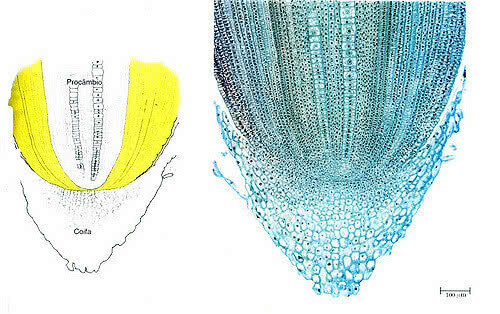 Apical meristem covered by the cap. In the outermost region we find the protoderm and in the median, the fundamental meristem.
Apical meristem covered by the cap. In the outermost region we find the protoderm and in the median, the fundamental meristem.
Secondary Meristematic Fabric
Secondary meristematic tissue promotes thick plant growth (secondary growth).
Secondary meristematic tissues are: cambium and phelogen.
O exchange gives rise to secondary xylem and phloem.
O phelogen gives rise to suber and feloderm.
You must always remember that primary meristematic tissues give rise to primary tissues. While secondary meristematic tissues, they give rise to secondary tissues.
Adult Fabrics
Adult or permanent tissues are differentiated and classified according to the function they perform. In this case, they can be from coating, padding, support and driving.
Coating Fabrics
Plants have the lining tissues for the protection of leaves, roots and stems.
The lining tissues are the epidermis and periderm (suber, phelogen and pheloderm).
THE epidermis it is made up of a layer of intimately bonded, chlorophylled living cells. In leaves, the cells of the epidermis secrete the substance cutin, which forms a lipid cuticle and prevents excessive water loss through perspiration.
The epidermis may have some types of attachments:
- stomata: Allows gas exchange with the environment during photosynthesis and respiration.
- hydathodes: structures located on the edges of the leaves that eliminate excess water from the plant.
- Trichomes: present in xerophytic plants, they reduce the loss of water by the stomata, when they open to carry out gas exchange.
- By the absorbents: found in the hairy zone of the root, they help in the absorption of water and mineral salts.
- Accules: sharp and rigid structures, often confused with thorns, which provide protection to the plant.
THE periderm it is living tissue. Represents the lining of roots with secondary growth. It consists of the suber dermal tissues, phellogen and feloderm.
Among the structures of the peridermis are: the lenticels it's the rhytidome. Lenticels are openings in the peridermis that allow air to circulate. The rhytidomes are the most superficial layers of the peridermis, which when dead, detach from the plant stem.
Filling Fabrics
They are tissues formed by cells that fill the spaces between the lining tissues and the conductive tissues.
Filler tissues are represented by parenchyma, found in all plant organs.
O parenchyma it is formed by living cells with great capacity for differentiation and can have different types:
Filling Parenchyma: performs filling between fabrics. Example: Stem cortex and medulla.
Chlorophyllian Parenchyma: assists in the process of photosynthesis. It is found in leaves and can be of two types, palisade and spongy.
Reserve Parenchyma: stores substances such as starch, oils and proteins.
According to the stored substance, there are different names:
When it stores starch, it's called starchy parenchyma. Example: tubers, such as potatoes.
When you store water, it's called aquifer parenchyma. This tissue is common in xerophytic plants.
When it stores air, it's called air parenchyma. An example is aquatic plants. It is the air parenchyma that allows these plants to float.
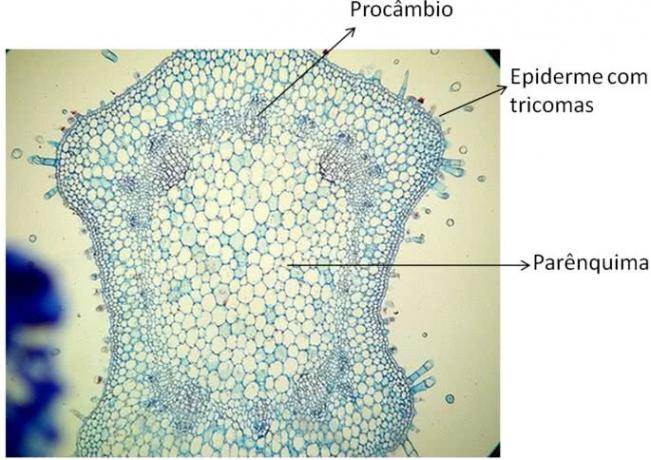 Location of the parenchyma, procambium and epidermis
Location of the parenchyma, procambium and epidermis
Support Fabrics
Originating from the fundamental meristem, these tissues are found in leaves, fruits, stem and root.
The supporting tissues are the colenchyma and sclerenchyma.
O collenchyma it consists of living cells, elongated and rich in cellulose. They are present in the youngest parts of plants, just below the epidermis. It gives flexibility to plant organs.
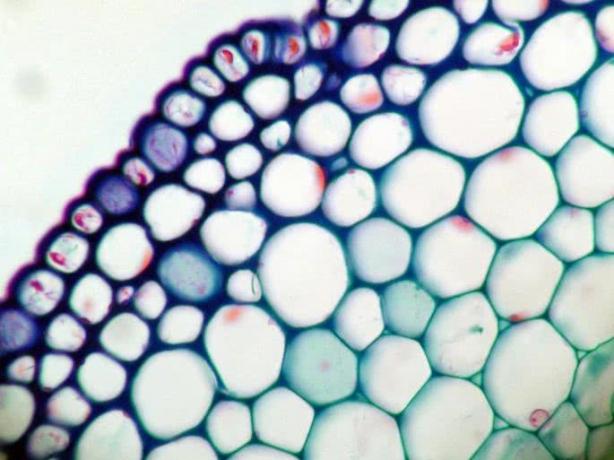 Collenchyma in the blue colored region
Collenchyma in the blue colored region
O sclerenchyma it consists of dead, lignified and elongated cells. They are present in the oldest parts of plants.
Conduction Fabrics
Conductive tissues are responsible for transporting and distributing water and substances throughout the plant's body.
The conductive tissues are the xylem and the phloem.
Xylem and phloem can be primary or secondary. The primary ones originate from the procambium and the secondary ones from the vascular cambium.
O xylem, also called wood, is made up of dead cells and a cell wall reinforced by lignin. This tissue is responsible for carrying the raw sap (water and mineral salts) from the roots to the leaves. Its main cells are the tracheids and vessel elements.
O phloem, also called liber, is made up of living cells. The phloem transports the elaborated sap (organic matter) from the leaves to the stem and roots. Its main cells are the sieved tubes and companion cells.
Want to know more about plants? Read too:
- plant kingdom
- Botany: the study of plants
Exercises - Test your knowledge
(UFR-RJ) - In research carried out with eucalyptus, it was found that from the buds of a single branch it is possible to generate about 200,000 new plants in approximately two hundred days; while the traditional methods allow obtaining only about one hundred seedlings from the same branch. Tissue culture is made from:
a) of meristematic cells
b) from epidermal cells
c) of suber cells
d) from sclerenchyma cells
e) from wood cells
a) of meristematic cells
(U. AND. Londrina-PR) - The following are important vegetable support tissues:
a) Phloem and xylem
b) Collenchyma and sclerenchyma
c) Reserve parenchyma
d) Suber and rhytidome
e) Cortex and central cylinder
b) Collenchyma and sclerenchyma
(PUC-PR) - Relate plant structures to their specific functions and then mark the correct alternative.
STRUCTURE
I. Liberian vases
II. spongy tissue
III. colenchyma
IV. Specialized epidermal cells
V. sclerenchymatic fibers
OCCUPATION
a) Transport of water and mineral salts
b) Air circulation and photosynthesis
c) Elimination of water in liquid form
d) Increased water and mineral salts absorption surface
e) Support and flexibility
a) I-a, II-b, III-c
b) I-b, II-d, IV-a
c) III-e, IV-b, V-a
d) II-b, III-e, IV-d
e) II-e, III-a, IV-e
d) II-b, III-e, IV-d


